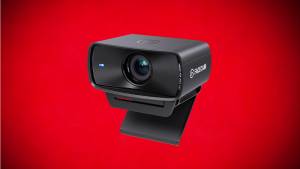Elgato HD60 X Capture Card

design
After a few attempts, it seems like Elgato have finally found their rhythm when it comes to external capture card design. Unlike previous iterations which looked a little toylike, the HD60 X just looks right for what it is. Small and discrete enough to disappear into the background, but refined and professional enough to enjoy when it does catch your eye. There’s no gamer RGB here either, just a solitary blue status LED on the front to let you know everything is running as it should.
Build quality is where you’d expect from something in the Elgato range, though the HD60 X’s all plastic construction did leave me feeling a tad wanting. The body feels premium enough but there’s absolutely no weight to the unit (just 91g to be precise) and a metal base plate would have added some reassuring overall heftiness. The lack of weight meant I actually found it hard to get the HD60 X to sit flat. Even the included HDMI cable caused the card to lift off the table at the back and float at an angle.

The HD60 X’s new form factor is certainly logical upgrade over previous models though. Gone is the ‘in one end and out the other’ approach, instead the HDMI in, HDMI out and USB Type C connections are now all grouped together on the back of the unit. Such a small change seems so obvious in hindsight, the HD60 X can now happily sit tucked away at the back of a desk or TV unit with cables neatly tucked away out of sight.
performance
On the whole the HD60 X delivers impressive visuals with next to no setup required, as long as you avoid Elgato’s software.
check latest prices
This is the one major weak spot with the HD60 X experience – just don’t bother downloading Elgato’s own 4K Capture Utility which was clunky and frustrating. There was noticeable latency between the passthrough and captured content, discrepancies between settings and output and what it did record had issues with black screens and choppy frame rates. All the while, the passthrough video on my TV was rock solid and delivering quality to the point you wouldn’t know there was a middleman along the way.

Thankfully things couldn’t have been more different when switching to OBS, where everything was buttery smooth and the HD60 X shone. Windows instantly recognised it as a video capture source and delivered a quality, latency-free feed. Playing Far Cry 6 from a Series X looked great both on my LG CX via passthrough and provided an equally excellent image on my laptop via the USB cable, even during fast motion gunfights. In fact the feed to OBS was so strong I’d have quite happily played via that alone, even while recording.
Compared to Elgato’s cheaper Cam Link 4K, the HD60 X is in a different league. Clarity, colour and frame rates were all significantly stronger and the Cam Link 4K coughed a few times in high action moments with no option for passthrough.
summed up
If you’re looking for a simple, flexible way to capture great looking content then you can’t go wrong with the Elgato HD60 X. As a plug and play option at a reasonable price point it delivers excellent quality video that will exceed the needs of most mid-range creators, particularly those looking to showcase AAA titles on next gen consoles.
It’s a neat, incremental update over the HD60 S+ without an increased price tag, so there’s little to complain about. Though S+ owners likely won’t find enough to warrant a new buy, for first timers or those due an upgrade it’ll deliver what it promises. Just stick with OBS on the software side.














